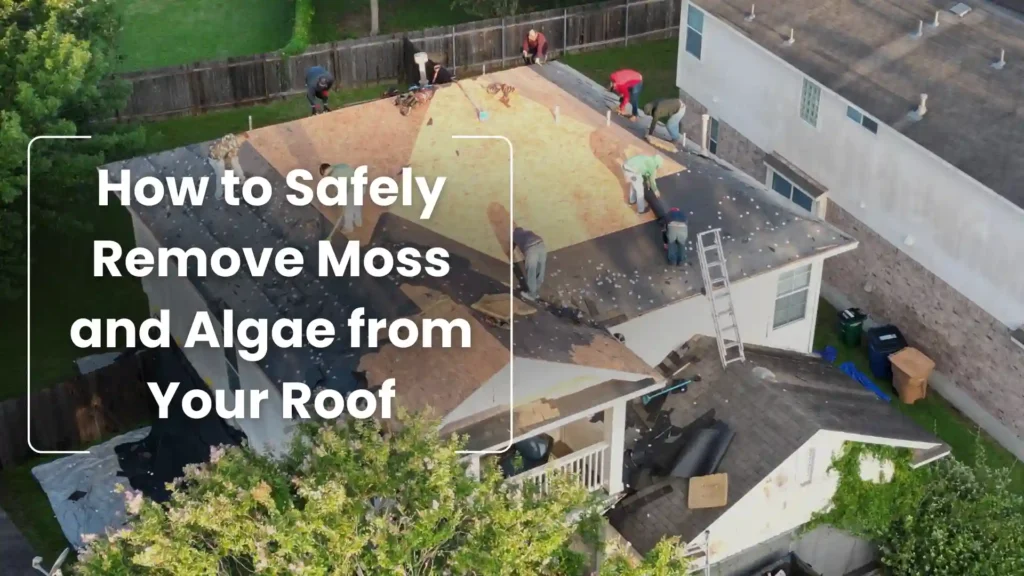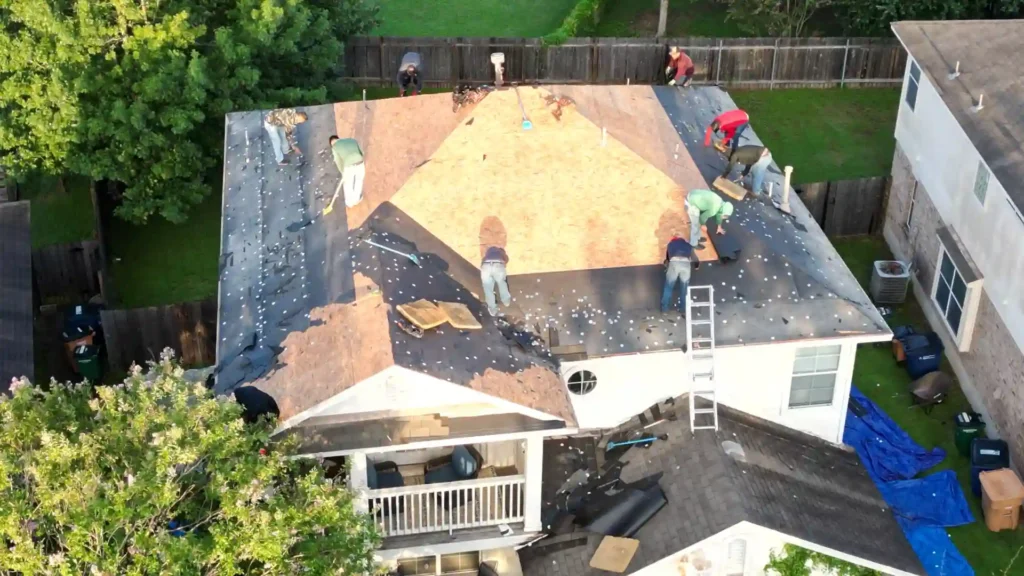How to Safely Remove Moss and Algae from Your Roof


Some people turn a flat roof into a garden oasis. But when ponding water and poor drainage lead to a bog filled with moss and algae, that’s a problem. Not only are moss, algae, and mold an eyesore, but they can also damage roofing materials over time. These organic growths can cause rot, leaks, water damage, and structural issues that can compromise the safety of your roof.
Cleaning and removing moss and algae from the roof is a delicate process. Doing it the wrong way or with the wrong products can cause further damage to your roof. It’s time to walk through effective, roof-friendly methods for removing moss and algae. Understanding what to avoid and when to call a professional can help keep your roof strong and beautiful for years.
Why Does Moss Grow on Roofs?
Moss, algae, and mold are plants and fungi that thrive in moist, water-rich environments. These organic growths can’t survive without ample moisture, shade, and cool conditions. A flat or low-sloped roof without adequate drainage is the perfect place for moss and algae. Without proper drainage, water ponds on the roof when a storm rolls through. As it sits and stagnates, moss and algae can grow. Moss growth on roofs is widespread in regions with high humidity or frequent rainfall.
North-facing roof slopes or areas shaded by trees often receive less sunlight. These conditions also allow moisture to linger longer after rain or dew. Moss spores from wind or birds settle in these damp areas and grow.
Eventually, moss and organic materials can trap even more moisture, accelerating the spread of moss. Over time, these growths damage roofing material and potentially underlying structures. Rot, water damage, leaks, and mold can compromise a roof’s strength. Left untreated, moss can significantly shorten a roof’s lifespan and cause major safety concerns. Organic growth and excess moisture can also attract pests, which can cause even more damage to a roof, attic, or home interior.
Mold is also attracted to the same environment as moss and algae. Mold growth causes its own set of issues. Not only does it degrade the quality of your roof, but mold spores can also be harmful to breathe, causing health concerns.
How to Remove Moss from Your Roof
Removing moss and algae from your roof can seem like a daunting job. You can safely remove moss and help prevent long-term structural damage with the right tools and some elbow grease. The following tips can help you clean your roof and prevent further.
Always Put Safety First
Before you set foot on your roof, put safety first. Wear non-slip shoes, use a sturdy ladder, and enlist someone to help hold it. Invest in a safety harness to help prevent injuries from falls.
Gather the Right Tools
You need the right tools for the job. To remove moss, use a soft brush or broom. You should also grab eye protection and gloves. If you are concerned about mold spores, have breathing issues, or a compromised immune system, consider wearing a respirator mask or an N95.
Use a Soft Brush or Broom
Gently brush off the moss using a long-handled soft-bristle broom or brush. Start at the top and work downward to avoid lifting shingles. Do not brush against the shingles. It may be tempting to complete the job using a pressure washer more quickly, but avoid these products. A pressure washer can damage shingles and roofing materials.
Apply a Moss Removal Solution
Once the bulk of the growth is removed, use a commercial moss remover. You can also use a DIY, eco-friendly moss removal mixture of 50/50 water and bleach or vinegar. Spray the solution on affected areas and let it sit for 15 to 20 minutes. Always follow the manufacturer’s instructions if you are using a commercial product.
Clean Gutters and Debris
Remove moss that has fallen into your gutters or onto the ground to prevent it from spreading or causing clogs. Now is also an excellent time to clean and inspect the gutters to ensure they are properly draining water. Functioning gutters can reduce excess moisture from sitting on your roof and prevent future moss growth.
Prevent Future Moss Growth
Consider other preventative measures. A treatment like zinc sulfate or sodium diacetate can help inhibit future moss growth. You can also install zinc or copper strips near the roof ridge. Rainwater will carry ions from the metal down the roof, naturally inhibiting moss growth.
When to Call a Professional

Sometimes, seeking professional help with moss and algae growth may be appropriate. Minor growth generally responds well to DIY solutions. However, significant moss or algae accumulations may require a roofing expert to remove and treat. Consider calling in expert help in the following circumstances.
There is Extensive Moss Coverage
If moss or algae growth is excessive, it may be embedded in the shingles. Professional tools and techniques are needed to remove it without causing damage. Excessive moss and algae growth may also indicate that the roof could have water or structural damage. A roofing professional can inspect the roof’s structural integrity and has proper safety gear to ensure accidents don’t happen.
Steep or High Roof
If your roof is steep, multi-story, or otherwise challenging to access, it’s safer to have trained roofing contractors do the job.
Shingle Damage or Roof Deterioration
Single damage, sagging, and other signs of damage mean the roof may be unsafe. A professional can assess the roof’s condition, evaluate the damage, and clean it appropriately. If shingles are brittle, cracked, or lifting, scrubbing and chemical solutions could cause damage.
Recurring Moss Problems
If you’ve tried DIY solutions and the moss keeps returning, a roofer can help identify underlying moisture issues.
Uncertainty About Cleaning Methods
If you are unsure what tools and chemicals to use to clean your roof, leave it to the pros. Using the wrong solution or tools can void your roof warranty or reduce lifespan.
You Have a Health Condition
If you have a health condition or are immunocompromised, allow an experienced roofing contractor to assess and clean your roof. Breathing in mold and other spores can cause issues.
Clean Up with Help from the Team at RoofsOnly.com
Protect your roof, landscaping, health, and home by contacting a roofing specialist at RoofsOnly.com. Our team can inspect your roof, identify issues causing moss growth, and clean it. We don’t just wash the problem away. We help you find practical solutions that prevent the issue from recurring while extending the lifespan of your roof.
Contact our team now and ask for your free roof inspection to get started.
